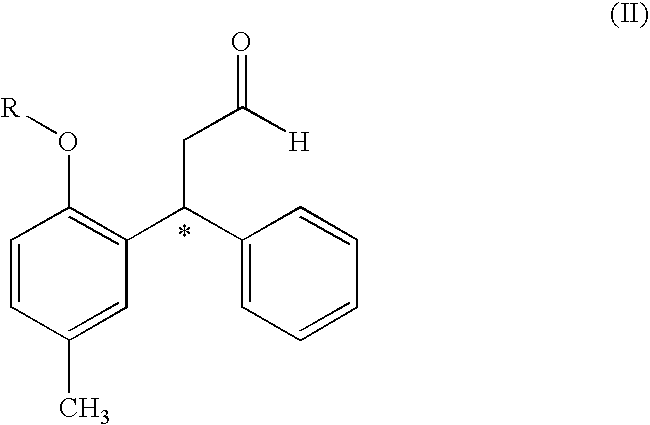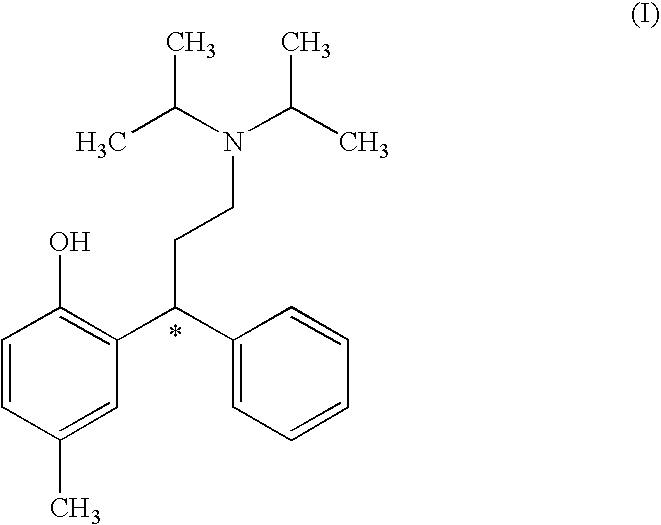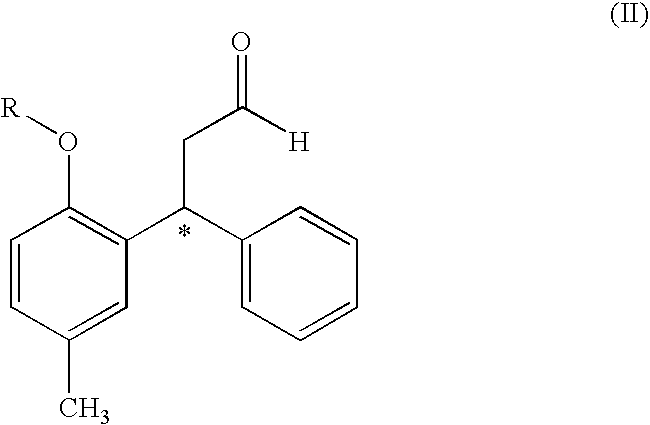Process for Obtaining Tolterodine
a technology of tolterodine and methyl iodide, which is applied in the field of tolterodine extraction, can solve the problems of high cost, low total yield, and hazard in use of reagents such as methyl iodide and lithium and aluminum hydride, and achieves short reaction time, good yield and pharmaceutical quality, and high yield
- Summary
- Abstract
- Description
- Claims
- Application Information
AI Technical Summary
Benefits of technology
Problems solved by technology
Method used
Image
Examples
example 1
2-methoxy-5-methylbenzophenone
[0058] SnCl4 (47.5 ml, 0.41 mol) was added dropwise to a mixture of 4-methylanisol (100 g, 0.82 mol) and benzoyl (95.15 ml, 0.82 mol) in 500 ml of CH2Cl2 at 0° C. Once the addition is complete, it was allowed to react for 3-4 hours, allowing the mixture to reach room temperature. Once the reaction concluded, the mixture was cooled at 0° C., hydrolyzed with a mixture of concentrated HCl (41 ml) in H2O (376 ml), washed with 2×50 ml of NaOH (10%), dried and evaporated to give 140 g (78%) of the title compound in crystalline solid form.
example 2
(2-methoxy-5-methylphenyl)phenylmethane
[0059] BF3.THF (204 ml, 1.86 mol) and NaBH4 (46.8 g, 1.24 mol) were added to a mixture of 2-methoxy-5-methylbenzophenone (140 g, 0.62 mol), in 840 ml of THF, and it was slowly heated to the reflux temperature (60° C.), maintaining it for about 6 hours. Once the reaction concluded, the mixture was cooled, added to 500 ml of NaHCO3 (7%), and the organic phase was extracted with 200 ml of ethyl acetate, washed with 3×50 ml of NaHCO3 (7%), dried and evaporated, giving a viscous liquid [122.5 g (93%)] containing the title compound.
example 3
3-(2-methoxy-5-methylphenyl)-3-phenylpropanol
[0060] BuLi (54.4 ml, 0.147 mol) was added to a solution of (2-methoxy-5-methylphenyl)phenylmethane (24 g, 0.113 mol), in 120 ml of THF at −78° C. Once the addition was complete, it was heated to room temperature and maintained at said temperature for about 2 hours. The temperature was again reduced to −78° C. and ethylene oxide (4.98 g, 0.113 mol) was added such that the temperature did not exceed −50° C. The reaction was allowed to take place, being complete after 2 hours. Then the mixture was hydrolyzed with 60 ml of NH4Cl, extracted with 30 ml of ethyl acetate, the organic phase washed with 2×25 ml of NH4Cl, dried and evaporated, giving 30 g (100%) of a viscous yellow liquid containing the title compound.
PUM
 Login to View More
Login to View More Abstract
Description
Claims
Application Information
 Login to View More
Login to View More - R&D
- Intellectual Property
- Life Sciences
- Materials
- Tech Scout
- Unparalleled Data Quality
- Higher Quality Content
- 60% Fewer Hallucinations
Browse by: Latest US Patents, China's latest patents, Technical Efficacy Thesaurus, Application Domain, Technology Topic, Popular Technical Reports.
© 2025 PatSnap. All rights reserved.Legal|Privacy policy|Modern Slavery Act Transparency Statement|Sitemap|About US| Contact US: help@patsnap.com



